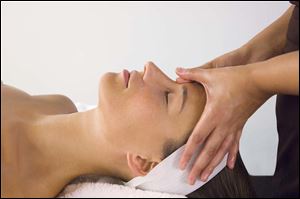
Treatments can revive your winter-weary skin
4/6/2014
Spa procedures or in-home treatments can rejuvenate dry, flaky skin.
Just because you’re ready for spring doesn’t mean your skin is.
Shedding the armor of bulky winter clothes we’ve hibernated in for months could reveal dry, patchy, flaky skin — side effects of winter’s icy breath (and the heaters and hot showers used to fight it).
With age, the sting of cold weather on skin can be worse as cell turnover rates decline and skin doesn’t maintain as much moisture and elasticity it once did in its early 20s.
But there’s good news: There are remedies you can follow at home or seek at a salon to rejuvenate winter-weary skin.
At-home treatments
“Prevention is key,” says Suzan Obagi, director of the University of Pittsburgh Medical Center Cosmetic Surgery and Skin Health Center.
Try placing a steam or mist humidifier in the bedroom to put moisture back into the air as you sleep or invest in a whole-house humidifier that can be installed near the furnace. Cutting back on lengthy hot showers is another option to keep skin from getting dried out.
RELATED: Products to repair damaged skin
Removing the dead layer of dry, excess skin also is essential to enabling the face and body to reclaim a youthful glow.
“The first thing that people need to do is consider their own skin,” says Nicki Zevola, founder and CEO of FutureDerm Inc., a line of skin care and beauty products. “You have to consider a number of factors” such as age, race, and skin sensitivity.
People — especially those with sensitive skin — should avoid granular body scrubs and washes, which can create small tears in skin and lead to irritation and blotchiness. Instead, opt for products with non-bead exfoliants or ones that have ingredients such as papain, an enzyme from papaya and pineapple that naturally dissolves old skin cells. (Ms. Zevola’s picks: AmorePacific treatment enzyme peel and Jan Marini’s Zyme green papaya mask.)
Gentle acids in lower strengths are other exfoliating options. Dominic Brandy, a board-certified cosmetic surgeon and founding medical director of the Skin Center Medical Spa & Cosmetic Surgery Center of Pittsburgh and Columbus, recommends products containing low concentrations of alpha hydroxy acid, beta hydroxy acid (salicylic acid), or glycolic acid applied with a cotton pad.
To help boost cell turnover, gradually incorporate an over-the-counter retinol cream (or the more potent, prescription-required Retin-A) to your skincare routine. Decades of clinical use back these products’ effectiveness at building collagen, peeling away flakiness, dulling early signs of aging, and brightening complexions, Dr. Brandy says.
And don’t forget old shower standbys such as a luffa sponge or glove or even a washcloth. They, too, can target dry patches.
Daily moisturizing is a must to add back to skin some of the softness winter stole. It’s best to apply lotions and moisturizers immediately following a shower while the skin still is damp. (Lotion on dry skin has minimal benefits, Dr. Obagi says.)
Help from the pros
For extra attention, consult a dermatologist, skin center, or spa for procedures that likely will provide more significant, longer-lasting results.
Microdermabrasion, a common exfoliation method, involves blowing aluminum oxide crystals onto the skin at high speeds to eliminate dead cells and give skin a refreshed look.
There’s also dermaplaning, in which a surgical blade is used to scrape off layers of dead skin.
A newer procedure that’s been popular at the Skin Center is the Dermapen, a pen-shaped tool with 11 needles at the tip that create tiny puncture points to allow creams and peels to better absorb into the skin.
Coupling a treatment with a chemical peel can heighten the results, Dr. Brandy says. Look for a peel that complements your skin’s needs, such as ones for acne, photo damage, or extra-dry skin.
Drink up
How your skin looks on the outside is greatly impacted by what goes inside. Drinking “lots and lots of water” is one way to hydrate the skin from the inside out, Dr. Obagi says.
Ms. Zevola starts each day with a green juice consisting of kale, spinach, cucumber, half a lemon, and apple from the Pittsburgh Juice Co. to support skin health. But stay away from juices that have been pasteurized and go for freshly squeezed and pressed ones, she says.
“At such high heats [of pasteurization], the enzymes often die, and the enzymes are great for skin.”
Antioxidants can neutralize free radicals that damage skin, so eating a high-antioxidant diet (meaning lots of fruits and vegetables or even a multivitamin) is another way to make skin more resistant to environmental elements and signs of aging.
Bare skin
Spring and summer bring with them their own threats to skin, particularly when it comes to potential harm from the sun.
Removing the layer of dry, dead skin cells, which can help reflect the sun’s damaging rays, can make skin more sensitive to the sun, Dr. Brandy says. Therefore, applying sunscreen amply and regularly is imperative to protect skin while outdoors or look for an SPF makeup.
But beware: Not all sunscreens are created equally, Ms. Zevola says. Physical sunblocks that contain zinc oxide or titanium dioxide perform better than other compounds because they don’t let ultraviolet rays reach the skin.
“I don’t think you can ever pay too much attention” to your skin, she says, but skincare is best when done with balance. If exfoliation, a sunscreen, or a professional treatment leads to prolonged, extreme itchiness, redness or pain, listen to your body and make adjustments.
The Block News Alliance consists of The Blade and the Pittsburgh Post-Gazette. Sara Bauknecht is a reporter for the Post Gazette. Contact her at: sbauknecht@post-gazette.com